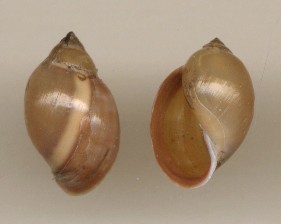Classification and Characteristics
Like any other living organism, Physella gyrina,
tadpole physa in English terms, is
put into a "tree" of classification. Organisms are classified
into their tree starting in a descending order: kingdom, phylum,
class, order, family, genus, and species. Classification methods
allow for the organization of individual organisms into similar
groups based on similar attributes, similar ancestors, and many
other topics for easier distinguishing (Allaby
2009). Below is the classification method for Physella
gyrina.

Kingdom: Animalia
Phylum: Mollusca
Class: Gastropoda
Order:
Basommatophora
Family: Physidae
Genus: Physella
Species: Physella gyrina
(Harold and Guralnick 2010)
Kingdom: Beginning Physella gyrina's classification scheme is the kingdom Animalia. The Animalia kingdom contains organisms that are multicellular, meaning that the organism contains more than one cell and is eukaryotic. Another distinct characteristic of the Animalia kingdom is the ability to reproduce by the fusion of eggs and sperm and the possession of a nervous system. Organisms in this kingdom are also heterotrophic and are unable to produce their own food; therefore, animals similar to Physella gyrina have to search for their nutritional needs (Oxford Dictionary of Biology: Sixth Edition 2008).
Phylum: As the second part of Physella gyrina's classification is the phylum Mollusca. Narrowing down on distinct characteristics, the phylum Mollusca is compromised of additional "requirements." Mollusca are coelomate (a fluid-filled body cavity that separates the muscles of an organism from the gut) invertebrates. Physella gyrina, and all other members of the phylum Mollusca, have bilateral symmetry and a calcium carbonate shell that allows for protection. Most members of this phylum also obtain a radula and a muscular foot (Allaby 2009).
Class: Following the phylum Mollusca is the class Gastropoda. As the classification schemes descend, more specific characteristics are added to each level of taxonomy. The class Gastropoda contains the terrestrial slugs and snails on this planet. These organisms lack gills and also contain an air-breathing lung. To distinguish a gastropod, it would be encouraged to look for a well-developed head with tentacles and eyes, a muscular foot, and a calcium carbonate outer shell. A distinct feature of this shell is that it is often spirally coiled like the shell of Physella gyrina pictured above (Hine 2005).
Order: The order Basommatophora contains both terrestrial and aquatic forms of slugs and snails; aquatic organisms being the dominant type. Each member of the order Basommatophora contains one pair of tentacles as well as eyes located at the base of organism's head (Concise Encyclopedia Biology 1996).
Family: Members of the family Physidae can be distinguished by their left-turned shell, also known as a sinistral shell. This left-turned shell is also the foundation for the body. A mantle skirt that contains two lobes can be seen on both the left and right sides of snails in the Physidae family. The snails in this family are typically 13 mm to 20 mm in length (Apple Snails 2007).
Genus: The genus name for Physella gyrina is Physella. A genus is a group of similar species that contain multiple similar characteristics (Hine 2005). For example, all snails with the genus Physella are aquatic pulmonate snails that are very common throughout North America specifically. Being a pulmonate snail, members of the genus Physella can live in water, but can breathe air as well through the means of a pallial lung, or also known as a lung sac, which is homologous to gills in other aquatic organisms. When Physella contract and expand their mantle muscles, they are able to breathe in air through a small opening. Members of this genus are often the prey of multiple organisms such as flatworms, leeches, fish, turtles, and many others. One of the main predators of members of Physella is crayfish (McCarthy and Fisher) (Gladys Archerd Shell Collection).
Species: The species name following the genus name for this organism is Physella gyrina. Members of this species are capable of reproducing year round, and usually have a medium to large outer shell. On the outside of the shell, a very large whorl is visible which is mostly has a convex shape. The Physella gyrina animal species are medium to dark grey in color and they also have white spots on their body (National Museums Northern Ireland).
Learn more about Habitat and Geography next!
Go home